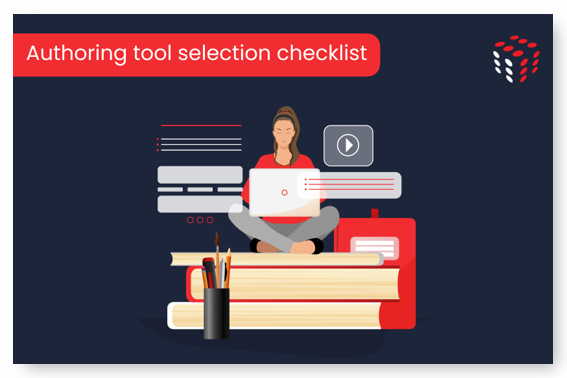
Whitepaper
How to Choose the Right Cloud-based e-Learning Authoring Tools?
Authoring Tool Selection Checklist

Table of Contents

Authoring Tool Selection Checklist
A 1-page checklist for organizations to evaluate key criteria when selecting an authoring tool like features, cost, ease of use. This compiles evaluation criteria without new research.
RESOURCES > WHITEPAPER > How to Choose the Right Cloud-based e-Learning Authoring Tools?
Today’s fast-paced business world is looking for intelligent solutions to their ever-changing training demands. In addition, they want to reduce the time and cost of creating e-learning. Authoring tools can assist you in producing high-quality training on a large scale and promptly!
You’ve probably had several discussions with your training managers about which rapid e-learning authoring tool is best for your online training programme. Authoring tools are classified into two types: desktop-based authoring tools and cloud-based authoring tools. Every authoring tool has advantages and disadvantages. Nonetheless, it can be challenging to execute a winning blueprint if your authoring tool restricts you from delivering business results.
While your authoring tool requirements may vary depending on your training requirements, budget, and other factors, there are critical questions to consider before making a decision based on your organisation’s needs before a purchase and time investment in a product.
What are Authoring Tools?
Rapid e-learning course content is created using authoring tools. They come pre-loaded with quick e-learning components to assist you in improving your e-learning design and development processes. To make your rapid e-learning courses more engaging and entertaining, use authoring tools to create templates, integrate interactivities, quizzes, and games, and generate evaluations.
Now that you’ve learned a little about authoring tools, you should know they’re divided into two types.
Types of Authoring Tools
Every authoring tool is unique, with its own set of features. In addition, authoring tools are classified as either desktop-based or cloud-based.
Desktop Authoring Tools
Desktop authoring software can be kept locally on your computer’s hard drive. In addition, many desktop solutions now operate on a subscription basis rather than paying for a one-time licence.
Although the desktop-based authoring programme gives you access to online storage, the tools usually reside on your local hard drive. Collaboration is, therefore, impossible. You risk causing damage when you save changes to an e-learning course to OneDrive or Dropbox. Desktop-based authoring tools are better suited for backup storage than central asset management.
Even if you can sync your data for centralised access and backup storage, you’ll still have to deal with multi-device access, licencing, and version issues, not to mention remembering to back up your files regularly. Compatibility between OSs (operating systems) is also a much larger issue than desktop software manufacturers would admit. Any workarounds that aren’t native to your operating system can cause performance issues.
Desktop software is not the best solution for anyone who wants to manage course data from a centralised location and has a medium or large production team with multiple reviewers.
Cloud-Based Authoring Tools
The alternative to desktop-based authoring tools is cloud-based, accessed through any browser. Previously, cloud-based publishing tools were almost always less effective than their desktop counterparts. However, they are now as powerful and feature-rich as any desktop application, if not more so. All that remains is for you to select the best one.
The primary benefits of cloud-based authoring software are file access, permissions management, and several built-in tools for collaboration and supervision. However, because coauthoring and collaboration features in cloud-based authoring tools come in various shapes and sizes, you must research to determine what best meets your needs.
Mobile-first responsive design technology is also usually enabled by cloud-based solutions. The demand for distributed and collaborative authoring solutions is growing as businesses embrace rapid e-learning courses to meet changing business goals and achieve productive learning objectives.
There are tonnes of cloud-based Authoring tools. One such tool is eAuthoring, which was developed for SAP SuccessFactors LMS users so that they can create courses directly within the SF LMS and then publish them to the main learning catalogue with a single click.
Why Cloud-Based Authoring Tools are the Way to Go?
One
There are no programme installations. Traditional desktop authoring tools require complex software installation, IT teams’ assistance, and ongoing maintenance and file downloads. Cloud-based authoring tools do not require downloads. When used, they respond almost instantly.
Compared to desktop authoring software, cloud-based e-learning tools are automatically updated, so there is no need to wait for new features and versions. This is useful if the cloud-based authoring tool includes built-in content libraries that can be automatically updated. Unfortunately, desktop-based
authoring tools also require more time to update, which is inconvenient for e-learning design and development. When you install an authoring solution on your desktop, you must perform your backup procedure. This implies that you are in charge of hosting and safeguarding sensitive data on the servers of your computers. If your equipment fails, hackers may gain access to your data, which may be compromised or even erased. Cloudbased authoring tools ensure the security of your e-learning content at all times.
Furthermore, it is part of your software vendor’s prerogative to safeguard your data against cyberattacks.
Two
Developers must work independently when using traditional desktop-based authoring tools. Except for external communication channels, each developer is an isolated entity, unable to access or examine their team’s work.
Multiple developers could work on the same file and share it with other developers on the team using cloud-based e-learning authoring tools. This makes the development process more efficient and adaptable. This also helps e-learning solution providers compare slides and choose the best learner-centred design. All of this is possible without having to work from a specific location.
Digitalisation has accelerated the transition to cloud-based authorship for corporate e-learning programmes. With cloud-based authoring tools, you won’t worry about e-learning data files being locked on a single desktop. It is also easier to set up and manage shared central resources for e-learning projects with cloud-based e-learning authoring tools.
Three
Because of desktop software installation, you can access authoring tools even if you don’t have an internet connection. But, of course, some features are only available online. The only advantage of desktop-based tools is their accessibility; however, you lose access to the authoring tool once you leave your computer.
Furthermore, desktop-based authoring solutions require multiple licences if you need access to various PCs; however, cloud-based authoring tools work on any device with an internet connection. Instant access from anywhere is critical in this day and age of growing, remote teams.
Four
Subject Matter Experts (SMEs) and organisational review teams only examine e-learning courses once they are ready for review using desktop-based authoring tools. For each stage of course development, you must create and upload files. Furthermore, because SMEs must print documents, add input to hard copies, and email scanned copies to their e-learning partner, reviewing PPT storyboards takes significant time.
Your reviewers can evaluate training material concurrently using cloud-based technologies and access it via a link provided by your e-learning partner. You could also make context-specific remarks and read each other’s comments. This enables you to address inconsistencies and ensure that the training content is consistent and understandable.

Craft Captivating eLearning
Choose the Right Authoring Tool Today!
The Key Benefits:
- Effortless Evaluation
- Confident Choice
- Engaging Learners
- Seamless Integration
Other Features to Consider
Quizzing & Assessments
The types of quizzes and assessments you use in online training can directly impact learner engagement and knowledge retention metrics. If your learners have difficulty remembering information, you may need to consider more sophisticated options.
Most authoring tools provide multiple-choice, matching, and other common assessment types; however, a robust tool will provide you with additional options, such as game-based, randomised testing, and adaptive questions. A modern authoring tool should also allow you to personalise quizzes with variables and branching.
How Do You Collaborate With Others?
You may want to share your course with others as you build it, whether from a template or from scratch. All developers and designers require a simple method for collecting stakeholder feedback and reviewing edits from subject matter experts (SMEs). Furthermore, some projects may necessitate collaboration with a large team of developers.
You may be collaborating with other developers on the same project in addition to subject matter experts and stakeholders. You’ll need a cloud-based tool that helps rather than hinders teamwork.
Multiple people can collaborate on an e-learning project using collaborative authoring tools. They typically include versioning features that track changes, similar to Google Drive. Only cloud-based authoring tools allow authors to collaborate on the same course simultaneously.
You can collaborate with other developers to create an efficient e-learning development workflow using collaborative authoring. Furthermore, because everyone can see changes as they happen, there is greater transparency about what is being worked on, and no one is doing the same. Furthermore, because all of your work is stored in the cloud, you can access it from anywhere without worrying about hard drives failing or running out of storage space. Another advantage is that you can access your authoring tool from any browser, so you’re not limited to your office’s primary desktop computer.
Working with a single vendor has benefits that can’t be denied. But there are also bad things about working with a single vendor. You may be familiar with the saying, “Jack of all trades, master of none.”
It can feel like an all-in-one solution has tools for every job, like a Swiss Army knife, but none of them is suitable for the job. Especially when these all-in-one companies expand their breath via acquisitions instead of organic growth negating the perceived benefits of “seamless integrations.”
Even if they grew organically, the number of resources to support each feature could vary. One can expect more headcounts (and money) behind the cash cow product and perhaps just a team of one FTE and an intern to support a brand new feature to tick the checkbox.
How Can You Have the Best Authoring Experience Possible?
After you’ve evaluated the main features of each authoring tool you’re considering, you might want to consider other benefits (or red flags) that could have a direct impact on your user experience, such as
- Integrations
- Help
- Value
You can save valuable time and money when your e-learning tools work together.
Easy-to-use, well-designed templates, intuitive ways to solicit stakeholder feedback, robust features for building practical assessments, accessible content, and responsive, interactive e-learning are among the best tools. Of course, it’s up to you whether you want features like collaborative authoring and extensibility, but hopefully, we’ve helped you determine if those options would benefit you.
Productivity and profitability are driven by practical training. So select the tool that will allow you to provide the best training possible.
About Rolling Arrays
Rolling Arrays has been driving SAP SuccessFactors-led HR Transformation since 2009. The company specialises in SF consulting, implementation, and support and also builds applications to enhance the utility of the SuccessFactors platform. It is committed to designing systems that help its customers to attract, develop and retain talented individuals. In 2021, Rolling Arrays was recognized as one of the top 75 fastest-growing companies in Singapore by The Straits Times & Statista.



Share with your network
Get updates in your inbox